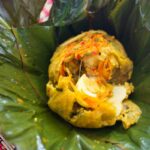If you enjoy keeping abreast of the latest trends and developments in the world of dining and cooking, you are likely to have come across something called yuzu on a few menus or recipe blogs.

This unique fruit has been used for years by mixologists, chefs, and bakers to bring something special to their creations.
However, you don’t have to be a professional in the hospitality industry to know how to use this intriguing citrus fruit. In this quick guide, we will tell you everything you need to know about the incredible yuzu fruit.
What Is Yuzu Fruit?
If you have seen yuzu mentioned on menus and in recipes, you might not be entirely sure what it is.
Yuzu is a sour and aromatic citrus fruit that is native to China and Korea, although it is most commonly found in Japanese cuisine. Yuzu is often confused with a lemon due to its similar color and flavor.
However, it is a different citrus fruit, although lemon can be substituted for it if you don’t have yuzu.
Despite sharing a stunning, bright yellow color with lemons, yuzu is actually shaped more like a small orange. Much like lemons, the yuzu fruit has a thick and bumpy rind.
It also starts out with a rich green color and turns yellow as it ripens on the tree. Yuzu fruits are bursting with seeds which means that they actually produce less juice than typical lemons or limes.
It is the lack of juice per yuzu fruit and the fact that it is difficult to harvest that makes yuzu so expensive when compared to other citrus fruits.
However, because of its unique flavor, it is still popular to use in dishes around the world.
What Does Yuzu Taste Like?
We mentioned above that yuzu has a unique and aromatic flavor. The best way to describe what yuzu tastes like is very sour. Many chefs describe the taste of yuzu as being a mix between a tangy lemon, sweet orange, and sour grapefruit.
For those with more refined taste buds, you can also taste notes of floral and herbal aromas that underline the main, bitter taste. Yuzu is also more fragrant than other varieties of citrus fruit.
Because of this, it is often used to add scent to food as well as flavor. When the fruit is ripe, it gives off a tangy, honeysuckle-like scent.
The Cultural Importance Of Yuzu
The flavor of this fruit alone is enough to see why it is popular in cooking. However, the fruit does also have some cultural significance.
As we mentioned before, you are most likely to come across yuzu in Japanese cooking.it is often added to soup, pastries, and sashimi.
However, it also plays a significant role in cultural celebrations in the country. This fruit is particularly popular during the winter solstice celebrations that take place in Japan.
It is said that taking a bath with yuzu in it will bring the bather good luck.
On the island of Shikoku, one of the biggest producers of yuzu in Japan, the fruit takes center stage for most celebrations. It is a highly celebrated product that is even used as the community’s emblem.
The island has a festival dedicated to the yuzu fruit every fall.
What Is Yuzu Used For?
Because yuzu is such a prized fruit in Japan, there are many things that it can be used for. Below are some of the most common uses for the fruit.
In Cooking
The most popular way that yuzu is used is in cooking. The juice of the yuzu can be used in the same way as the juice of a lemon or lime would be used.
Despite the fact that yuzu fruit produces significantly less juice than other citrus fruits, the flavor it brings is completely unique. The tartness of the juice is combined with herby and floral aromas that bring depth to any dish.
The zest of yuzu is also commonly used in many dishes. Adding the zest of yuzu to dishes adds a little bit of a tangy flavor and plenty of the beautiful fragrance of the fruit.

It is particularly common for yuzu zest to be added to cocktails, desserts, marinades, and vinaigrettes.
It is unusual for anyone to eat a yuzu fruit in the same way as they would an orange, it is possible to preserve the fruit in sugar to create a jelly or a compote that can be used in various types of tea.
One thing that makes yuzu incredibly useful in cooking is that it can be used at all stages of ripeness to achieve different effects.
The zest of an unripened yuzu fruit can be used as a garnish or as an agent to flavor various foods. It can also be used to make yuzu kosho, a fermented paste made from chili, salt, and unripened yuzu zest.
In Aromatherapy
Outside of the kitchen, yuzu fruit also has multiple uses in the aromatherapy and beauty industry. It is common for aromatherapy products to use yuzu as a fragrance.
The scent of yuzu is said to have a calming effect which is perfect for massages and meditation.
Like many citrus fruits, yuzu has a high concentration of vitamin C. This is known to help reduce the signs of aging on the skin. Because of this, yuzu is a popular ingredient in natural anti-aging products.
Where To Buy Yuzu
Yuzu can be difficult to find in the U.S. because the government does not allow the importation of yuzu. With that being said, it isn’t impossible. There are some farmers, particularly in the state of California who grow yuzu trees locally.
You should keep an eye out for green yuzu in grocery stores and farmer’s markets between August and October. You can expect to find yellow yuzu between November and December.
You can also find bottled and pasteurized yuzu juice all year round in Asian grocery stores.
Final Thoughts
Yuzu is an interesting citrus fruit that has a unique flavor and fragrance that is incredibly popular in Japanese cooking and in skin care products. Although this fruit can be difficult to find in the U.S. it is worth the hunt.
- How To Reheat A Cheesesteak - November 5, 2023
- What Are Three Must Have Kitchen Knives? - September 22, 2023
- How To Protect Edges Of Pie Crust - June 15, 2023








